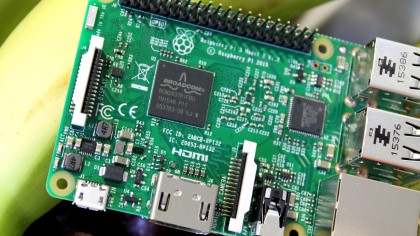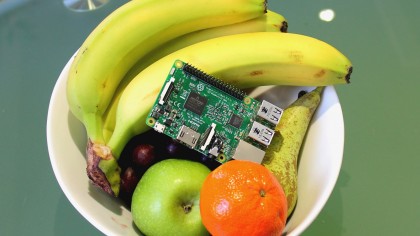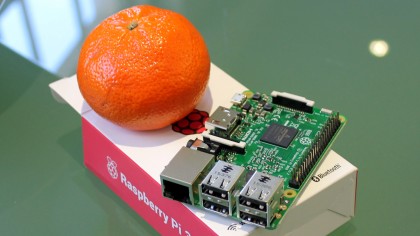How To Make A Raspberry Pi Laptop
TechRadar Verdict
The Raspberry Pi 3 provides enough computational power to make information technology a viable replacement for an old computer. Building on the legacy created over the last four years this board will ability many more projects to come.
Pros
- +
64bit quad cadre processor
- +
WIFI and Bluetooth baked into the lath
- +
Compatibility with existing hardware add ons
Cons
- -
Very power hungry and 2.5A power supply needed
- -
An evolution rather than a revolution
- -
Can get rather warm when pushed
Has information technology actually been four years since the Raspberry Pi blasted onto the single-board estimator scene? Well, information technology has and to celebrate the Raspberry Pi Foundation has released its latest version, Raspberry Pi 3, which is more of an development than a revolution.
The latest Raspberry Pi from the Raspberry Pi Foundation is here. Post-obit the Raspberry Pi 2 from ane year ago, information technology has new wireless connectivity and an improved processor that lowers the price of having a desktop figurer and opens the door board to heady new projects from simple servers to complex sensor networks and much more than.

Powered by a BCM2837 SoC (System on a Chip) and featuring a 64-bit ARM Cortex A53 quad cadre processor running at 1.2GHz, the Pi 3 has quite a powerful processor. However, there's no RAM upgrade this fourth dimension, which leaves it with 1GB of RAM. In that location is a subtle upgrade on Pi 3 is the VideoCore IV which handles video and graphics at present clocking in at 400MHz compared to earlier models at 250Mhz.
Physically the Raspberry Pi 3 looks very similar to the Pi two; the only noticeable changes are the locations of the condition LEDs and a new bit on the underside of the Pi. This flake is the BCM43438, which provides Wi-Fi b/k/n and Bluetooth on the board, and removes the need for USB dongles.
Bluetooth 4.1 provides both a classic and low free energy (LE) method of connecting to devices. Bluetooth LE is an exciting prospect as it enables low-power hardware applications, such equally beacons, that tin interact with devices such every bit smartphones and tablets.

Cleverly, the antenna used for wireless communications is located on the outer edge of the board, just out of the manner of any add-on boards that may interfere with the signal. In our tests we found the Wi-Fi to be as sensitive as the official Wi-Fi dongle and just as easy to use.
Congenital-in wireless communications is a large bargain for the Raspberry Pi and enables the Pi to be used as a an IoT (Internet of Things) platform for very petty outlay. To use these new wireless components you'll need to update your Raspbian image to the latest version or download and wink the latest image to an 8GB or larger micro SD carte.

The latest Raspbian epitome also comes with refinements needed for the Pi iii, such as new firmware that will enable the Pi 3 to run at full capacity. These new wireless devices do come at a price, with the Pi 3 consuming nearly one and half times more power than the Pi 2. This means that the Pi 3 needs a reliable power supply, with a recommendation being a 2.5A power supply when being used with add-on boards that use motors or neopixels.
The Pi iii comes with four USB ports and an Ethernet port, which provides Fast Ethernet, 100Mbit/s, and is routed via the LAN9514 scrap, which has been the standard since the Model B+ Pi was released in mid 2014. Many have criticised this decision as it prevents the use of Gigabit Ethernet, just adding that to the board would have increased the cost above the magic $35 (around £32, or AUS$47) toll point.
The Pi three provides an incremental speed increase when compared to the Pi 2, figures quoted past the Foundation state around 50-60% when running 32-chip code on the new processor. Currently, OSes practise not still utilise the scrap'south 64-flake mode; the speed boost is mainly due to a serial of architectural enhancements.

Final verdict
The Raspberry Pi 3 is a remarkable piece of applied science. Truthful, information technology may not exist the almost revolutionary upgrade from the Pi 2, but it builds upon a rich community of back up and maintains a level of backwards compatibility to boards and projects created for before models of Pi to be used.
The inflow of wireless communications on the board enables IoT projects at a lower price betoken and helps farther the goal of the Raspberry Pi, providing a platform for tinkering and experimentation that's low cost and well supported.
This review of the Raspberry Pi 3 was originally published in Linux Format. Click here to subscribe.
Source: https://www.techradar.com/au/reviews/pc-mac/pc-mac-desktops/raspberry-pi-3-1316838/review
Posted by: martincouseed1937.blogspot.com

0 Response to "How To Make A Raspberry Pi Laptop"
Post a Comment